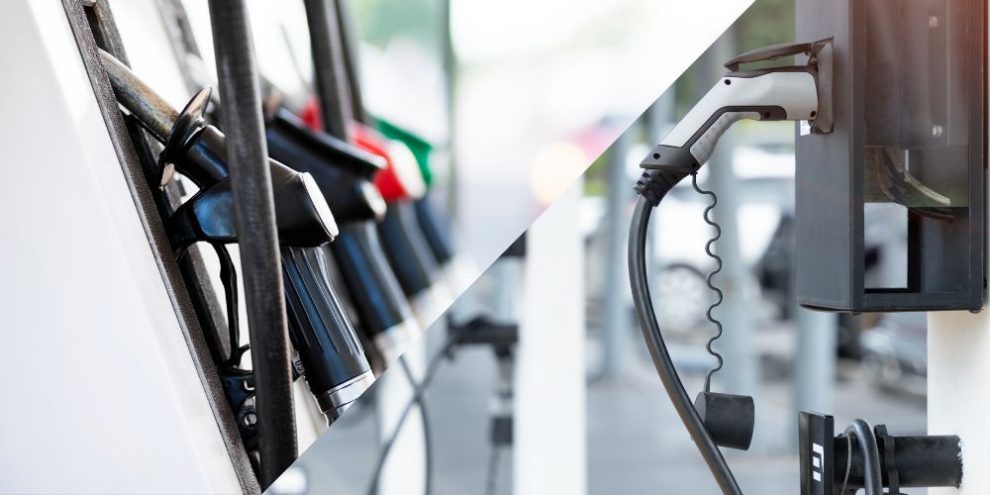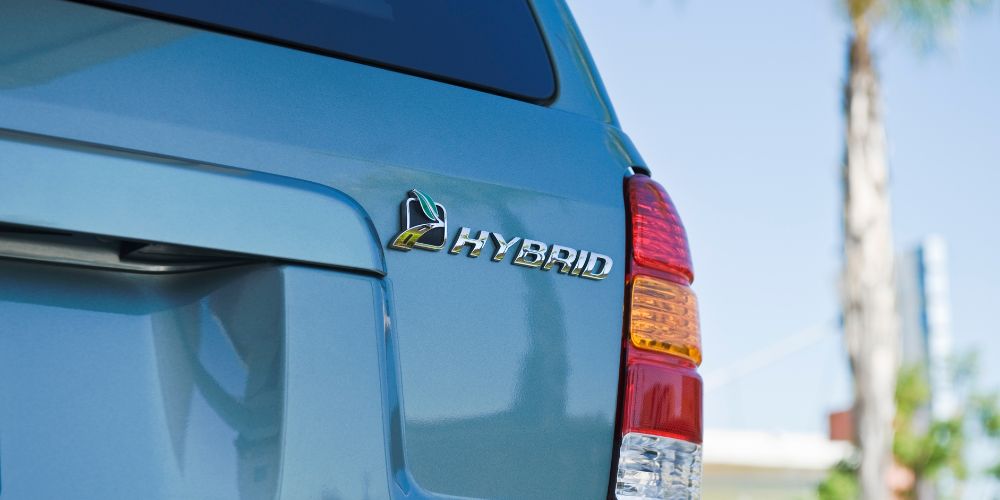
This Barrie 360 content is brought to you by Point S Action Tire
The world has become more aware of the importance of environmental sustainability. As a result, the popularity of green technology has increased rapidly. This has led to more people showing interest in electric and hybrid vehicles.
But before you decide which is best for you, it’s important to understand the difference between gas, electric and hybrid vehicles.
Gas Powered Vehicles
Gas powered vehicles use an internal combustion engine (ICE). These engines burn fuel to propel themselves forward.
The first vehicle with an ICE was built in the 1860s by Étienne Lenoir. This engine was a 2-stroke that only went about 6 km/hr. Over the next two decades, the engine would be refined by other innovators.
In 1886, Carl Benz built the first commercially produced gasoline motor vehicle with an ICE. The vehicle was the Benz Patent Motor Car.
Today, ICEs can be powered by gasoline, diesel, natural gas and even ethanol alcohol.

Advantages Of Internal Combustion Engines
When compared to other options on the market, ICEs generally have a lower purchase price. They also get better range.
On a full tank, most gas powered cars can get 500 to 700 kms. Diesel engines can usually get 1000 kms per tank to upwards of 2000 kms.
Keep in mind that these numbers do not reflect fuel economy. Some vehicles get more kms out of a liter of fuel. It’s why a small car can get 500 km on a 40 liter tank but an SUV needs a 60 liter tank to get the same range.
Another benefit of gas powered cars is that they have more power. This allows for easier acceleration, towing and hauling.
Finally, there are many fuel stations for ICEs … at least if you’re driving a gasoline or diesel vehicle. This means you can worry less about when you’re going to have to refuel your vehicle.
Disadvantages Of Internal Combustion Engines
ICEs have lots of moving parts that work together to propel your vehicle. As a result, they need more repair and maintenance. That’s because ICEs go through the following process 100s of times per minute:
- Intake - the piston gets pulled down in the cylinder. This opens the intake valve and lets fuel and air into the cylinder.
- Compression - the piston moves back up, closing the intake valve and compressing the air/fuel.
- Power - your vehicle's spark plugs fire and ignite the air/fuel mixture as the piston is pushed back down.
- Exhaust - the exhaust valve opens to expel exhaust and the piston returns to top.
These repetitive movements lead to a lot of wear and tear. In addition, ICEs are worse for the environment compared to other options on the market.
Firstly, ICEs have greater emissions. This is one of the main reasons manufactures are moving towards hybrid and electric. Secondly, while some fuels, like diesel, have renewable, sustainable and cleaner options, most ICEs use gas.
Gas is not renewable.
Summary
If you do a lot of long distance or strenuous driving, gas may be a better option. It may also be a better option if you tow, though tow capacities have improved with electric and hybrid.
Pros:
- Lower purchase price
- Better fuel range
- More power
- Lots of refueling options
Cons:
- High emissions
- Gas is not renewable
- Need regular engine repair and maintenance
Electric Vehicles
Electric vehicles (EVs) use an electric motor to propel your vehicle forward. Power to run the motor gets stored in high-voltage batteries.
INTERESTING FACT: Even though motor and engine are often used interchangeably, a motor runs on electricity and engines run on combustion.
At first glance, an EV may look the same as a gas powered vehicle. But under the hood, the two are completely different.
An EV has fewer moving parts. Their “engine compartments” contain an electric motor(s) and a controller. The controller converts power stored in the battery to power that can be used by the motor. It also regulates the flow of energy to control speed and acceleration.
An EV’s batteries replace the fuel tank of a combustion engine. They’re usually located under the vehicle or in the trunk.
Generally, you need to plug in an EV to charge it. However, EVs can generate energy as you drive, while reducing energy waste. There are two specific technologies used for this purpose:
- Auto Start/Stop - automatically turns off your engine when you’re stopped to conserve power. Once you push down the accelerator, the engine turns back on. Some gas vehicles use the same feature to reduce gas consumption and emissions.
- Regenerative Braking - When you coast or brake, regenerative braking recaptures kinetic energy. Your car then converts it to electrical power to charge the battery and run your motor.

Advantages Of Electric Vehicles
As with any vehicle, there are still EV parts that you’ll need to replace, including tires, wipers, brakes, etc. But because there are fewer moving components, your repair bills should be substantially less with an EV than a gas vehicle. There’s also no need for regular maintenance, such as oil changes and belt replacements.
RELATED: 7 signs it's time to get your brake's serviced ...
Another benefit is that most EVs don’t use a multi-speed transmission. While ICEs need multiple gears for power output, EVs have consistent power at any RPM. That means there’s no need for a gearbox or shifting. This also means that EVs have a smoother and quieter acceleration.
For those who like a manual transmission, don’t fret. There have been EVs produced with manual gearboxes.
While these are all excellent benefits, they’re just additional perks. The true advantage of an EV is that they have zero emissions. That means that EVs create no pollution during their day to day operation. They can also be conveniently charged at home, reducing the need to stop and “refuel”. They also have a lower cost to operate with electricity generally costing less per km than gas.
Disadvantages Of Electric Vehicles
While EVs have many benefits, they do come with some disadvantages. Firstly, if you do charge your EV at home, you may need to install a 240V station at your home. If you prefer to charge your car away from home, charging stations do exist. These stations are far less common than gas stations, but more are popping up every day.
Another potential pitfall of the EV is that they generally have a shorter driving range. Some EVs have a driving range as low as 150 km per charge. While you can find driving ranges upwards of 800 km, these vehicles come with hefty price tags. The Lucid Air Dream Edition, for example, costs $170,000 USD.
All this being said, the average EV generally gets around 300 to 400 kms per charge. This is a good range, but it has been known to give owners range anxiety. This is anxiety caused by worry that the car will run out of charge before you’ve reached your destination. This is especially problematic if you’re taking your EV on a roadtrip with limited charging stations along the way.
You also have to think about HVAC more in EVs than other cars. That’s because range can be further reduced if you’re using the HVAC system. This can be especially problematic in Canada’s winter weather if you don’t bundle up properly.
In one test, running the HVAC at different levels resulted in a 50 to 100 km drop in driving range. This was starting with a warm cabin, which means the drop could be greater if your car needs to be warmed up first.
Another disadvantage, when compared to gas vehicles, is that EVs can take 4 to 8 hours to charge. This charge time can be sped up with a fast charger, or slowed down using a standard 110V outlet if your vehicle allows it.
In addition, batteries for an EV can cost thousands of dollars to replace. The good news is that most batteries come with a 5 to 8 year warranty and are expected to last 10 to 20 years.
Summary
EVs are usually a better option for people who take shorter commutes or trips. Though, with the growing number of charging stations, long trips are less of an issue.
Pros:
- No emissions
- Smoother, quieter acceleration
- Can charge at home or at charging stations
- Electricity is generally cheaper per km than gas
- Less repair and maintenance
- Some cars have quick charge options
- Batteries last 10 to 20 years and have 3 to 5 years of warranty
Cons:
- Higher purchase price
- Average EV has a shorter driving range
- Driving range can be further reduced if using HVAC
- Usually takes 4 to 8 hours to fully charge on a 240V outlet
- Takes longer to charge with a standard 110V outlet
- Charging stations are less common
- You may have to install a 240V charging station
- Batteries are expensive to replace
Hybrid
As the name suggests, hybrids are a combination of gas powered vehicles and EVs. That means they have the combined benefits (and pitfalls) of gas and EVs.
Hybrid vehicles use a conventional combustion engine, but also have an electric motor. As a result, hybrids are equipped with gas tanks, as well as high-voltage batteries for power.
Hybrids are primarily powered by the gas engine. To charge and conserve electric energy, vehicles use auto start/stop and regenerative braking. The combustion engine can also charge the high-voltage battery.
Once charged, the electric motor assists the gas engine (electric power assist). It does this by boosting power to the ICE when accelerating, climbing hills and passing. This means the gas engine can be smaller, while achieving greater fuel efficiency and reduced emissions.
Hybrids can also drive in electric only mode, but the motor’s range is substantially lower than an EV. This is due to the smaller battery size. Most hybrids have an electric only range of 30 to 70 km, though some can push close to 100 km.
The type of hybrid described above is referred to as a regular or full hybrid electric vehicle (FHEV). There are, however, some different types of hybrids to be aware of:
Plug-In Hybrid Electric Vehicle (PHEV) - A PHEV has all of the same features of a full hybrid. As an added benefit, it can also be plugged into a power grid to charge. This means you can plug-in at home or at a charging station. FHEVs cannot be plugged in.
Mild Hybrid Electric Vehicle (MHEV) - MHEVs have auto stop/start, regenerative braking and electric power assist. They differ from FHEV because they cannot run on electricity only. MHEVs usually have a 48V battery instead of the high-voltage batteries found in FHEV.
Micro Hybrid Electric Vehicle - Micro hybrid vehicles have idle start/stop and regenerative braking. They do not offer electric only driving or electrical power assist. Instead, the power is stored in a standard 12V car battery to run the radio, AC, lights, etc. This means that the alternator does not have to draw power from the engine to charge the battery. Micro hybrids provide less benefits, but can still boast 5 to 10% better fuel economy and lower emissions.

Advantages Of Hybrid Vehicles
The primary benefit of any hybrid is improved fuel economy. Hybrids often, if not always, top the list of vehicles with the best mileage. This is because the electric motor helps reduce the power needed from the engine, lowering gas consumption.
This improved fuel economy translates into less visits to the gas station and lower emissions.
Hybrids are also a better option for renters, or people who live in apartments without charging stations. That’s because there it is not necessary to plug-in a hybrid, though you have the option with PHEVs.
If your commute is short or you take quick trips close to home, you can avoid using the ICE in PHEVs and FHEVs. This will reduce the number of fuel ups by relying solely on the electric motor. At the same time, you can go on long road trips without stressing about where to charge your car and when. That’s because hybrids have a better driving range than EVs.
If you’re driving a MHEV or microhybrid, the benefits will be slightly different. Both will get improved fuel economy and emissions, but to a lesser degree. You also won’t be able to depend solely on the electric motor in MHEVs or micro hybrids.
Disadvantages Of Hybrid Vehicles
The main disadvantages of hybrids are that they have a higher purchase price than gas powered vehicles. Because hybrids use combined technology, you will also have higher repair and maintenance bills. That’s because you still need to change oil, transmission fluid, coolant and belts. Though the frequency may be less often than with an all gas vehicle thanks to the assistance of the motor.
From an electric vehicle stand point, there’s still a risk that your high-voltage batteries will need to be replaced. But again, long life expectancy and warranties will make this less likely.
Finally because hybrids combine ICEs with EVs, they will generally have less power for accelerating. This is especially true when using the electric motor only. They will also be less energy efficient and produce more emissions than an all electric car.
Summary
Hybrids are a good option for people who do a combination of short commutes and long distance travel. That being said, benefits will not be as substantial if used primarily for long distance driving.
Pros:
- Generally have lower purchase price than EV
- Better fuel economy than gas
- Better driving range than EV, which means less stress on long trips
- Less trips to the gas station
- Lower emissions than gas
- More power than an EV for accelerating
- More convenient for renter and those living in apartments
- Cheaper than an EV
- Can run electric only on short commutes to reduce gas consumption
- Plug-in models can be charged at home or at charging station
- Don’t have to trade using the HVAC for better range
NOTE: MHEVs and micro hybrids have lesser benefits, but still offer improved economy and reduced emissions.
Cons:
- Higher purchase price than gas vehicles
- Expensive to repair and maintain, though generally cheaper than a gas vehicle
- Less power than gas for accelerating
- More emissions than EV
- Worse fuel economy than EV
- Still need to stop at gas stations if making longer trips or if battery is not properly charged and can’t plug-in
- May need to install a 240v charging station if you have a plug-in model
- Batteries are expensive to replace, though they shouldn’t have to be for 10 to 20 years
- Still uses a nonrenewable resource, if using gas, petroleum diesel or natural gas
Should You Choose Gas, Electric Or Hybrid?
Each type of vehicle has a long list of pros and cons. What works best for you will depend on many factors including:
- Budget
- Type of driving
- Whether you take long or short trips
- Local amenities
- And more
Before committing, be sure to do your research. This will help determine what makes the most sense for you.













